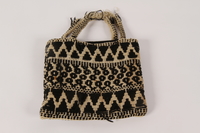Overview
- Description
- The Gerald Kaiser papers consist of three photographs. The first depicts Gerald Kaiser (born Jurek Kaiser), age of seven months, in the Kielce ghetto, Kielce, Poland, August 13, 1940, and dedicated to Aunt Geniusia from Jehuda (Jurek). The second photograph is a family portrait of Bernard Kaiser and Cesia Kaiser, with their son, Jurek Kaiser (later Gerald Kaiser) in the Kielce ghetto, Kielce, Poland, August 1940. The third is a photograph of Benard Kaiser holding his son, Jurek Kaiser, while Cesia Kaiser looks on, Kielce ghetto, Kielce, Poland, October 1940.
- Date
-
creation:
1940 August-1940 October
- Collection Creator
- Gerald Kaiser
- Biography
-
Gerald Kaiser was born on January 1, 1940 in Kielce, Poland. In 1941 the Gestapo took his family to a labor camp. Gerald, a small boy at the time, was smuggled out of the camp. Stanislaw, Jadwiga (Wanda), Janusz, and Krystyna Wlodek, and Franciszek, Teofila, and Aurelia Kowalik, two Polish Catholic families, saved his life from Nazi extermination. After Jadwiga Wlodek was taken to Auschwitz, her children moved Gerald (Jurek) to the Kowalik family in another village. In 1942, the Gestapo killed Bernard Kaiser, Gerald's father, in the labor camp. Jadwiga Wlodek died in Auschwitz in 1943. Sylvia Kaiser (Hirschler), Gerald's mother, survived. After liberation in 1945, she found Gerald at the Kowalik family's house. Mother and son went to Germany where they lived for a few years in the displaced persons camp at Bergen-Belsen. Finally they immigrated to the United States. From the United States, Gerald Kaiser contacted the people who saved his life: Krystyna and Janusz Wlodek and Aurelia Rudyk (Kowalik). Yad Vashem honored these families with recognition as Righteous Among the Nations in 1986. Kaiser planted trees for them. He maintained regular contact with the surviving members of these families. In the summer of 1993 they all met in Warsaw, Poland, at the conference sponsored by the Jewish Foundation for Christian Rescuers : "Can Indifference Kill?"
Physical Details
- Language
- Polish
- Genre/Form
- Photographs.
- Extent
-
1 folder
- System of Arrangement
- The Gerald Kaiser papers is arranged in a single series.
Rights & Restrictions
- Conditions on Access
- There are no known restrictions on access to this material.
- Conditions on Use
- Material(s) in this collection may be protected by copyright and/or related rights. You do not require further permission from the Museum to use this material. The user is solely responsible for making a determination as to if and how the material may be used.
Keywords & Subjects
- Topical Term
- Families.
- Geographic Name
- Kielce (Poland) Poland.
- Personal Name
- Kaiser, Jurek. Kaiser, Gerald. Kaiser, Bernard. Kaiser, Cesia.
Administrative Notes
- Holder of Originals
-
United States Holocaust Memorial Museum
- Legal Status
- Permanent Collection
- Provenance
- Professor Gerald Kaiser donated the Gerald Kaiser papers to the the United States Holocaust Memorial Museum in 2001.
- Funding Note
- The cataloging of this collection has been supported by a grant from the Conference on Jewish Material Claims Against Germany.
- Record last modified:
- 2023-02-24 14:04:28
- This page:
- https://collections.ushmm.org/search/catalog/irn510951
Download & Licensing
- In Copyright - Use Permitted
- Terms of Use
- This record is not digitized and cannot be downloaded online.
In-Person Research
- Request 7 Days in Advance of Visit
- Plan a Research Visit
-
Request in Shapell Center Reading Room
Bowie, MD
Contact Us
Also in Gerald Kaiser family collection
The collection consists of a knit bag and photographs relating to the experiences of Bernard, Cesia, and Jurek (Gerald) Kaiser and their family before and during the Holocaust in Kielce Ghetto, Chlewice, Lipnica labor camp, and Sosnowiec, Poland, and in Bergen-Belsen displaced persons camp after the war and of the Wlodek family in Lvov and Wegleszyn, Poland. Some of these materials may be combined into a single collection in the future.
Date: 1935-1948

Black and white knit bag used in slave labor camps by a Polish Jewish woman
Object
Lined hand knit pouch given to Cesia Kaiser in one of the camps she was imprisoned in from 1942-1944, either Skarzysko-Kamienna slave labor camp or the Hasag slave labor camp in Czestochowa where she was liberated at the end of 1944. Cesia received the bag from a German woman in the camp, either a fellow prisoner or a camp guard, who used it to hide sandwiches for Cesia.
Gerald Kaiser papers
Document
Gerald Kaiser papesr consists of testimornies and memoirs related to the Holocaust experiences of the Kaiser family. Also included are the Yad Vashem certificates for the Wlodek and Kowalik families as Righteous Among Nations for saving Gerald Kaiser; A Memoir of the Nazi occupation by Janusz Wlodek and Krystyna Wlodek; War Memoirs by Aurelia Rudyk; and Can Indifference Kill? A talk given at the Warsaw Conference, Gerald Kaiser, July 1993.
Gerald Kaiser photograph collection
Document
The Gerald Kaiser photograph collection consists of 68 photographs of the Kaiser family in the Kielce ghetto, Kielce, Poland, in Chlewice, Poland, in the Lipnica labor camp, Sosnowiec, Poland, and the Bergen-Belsen DP camp. Also included are images of the Zaks family in the Bergen-Belsen DP camp, and the Wlodek family of Lvov and Wegleszyn, Poland.
Gerald Kaiser papers
Document
The Gerald Kaiser papers consist of two photographs of Teofila Kowalik, a Polish woman, who hid Gerald Kaiser for three years in the village of Przylęk, Poland; one letter with envelope, written by Cesia Kaiser (née Zaks) in Tel Aviv, Israel to Stanislaw Wlodek, who hid Gerald Kaiser during the Holocaust, in Deszno, Poland; and one letter written by Tola Zaks, Gerald Kaiser’s maternal aunt in the United States, to Stanislaw Wlodek in Deszno, Poland.



